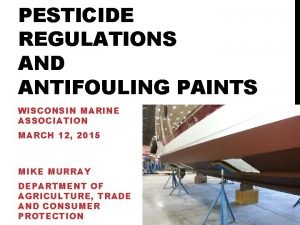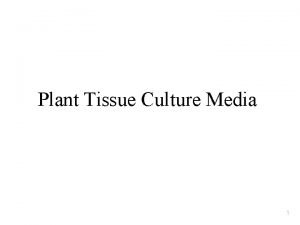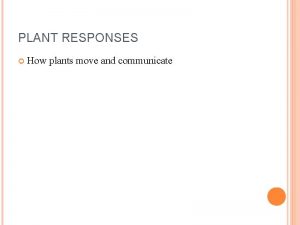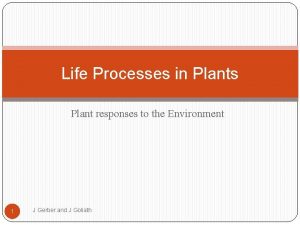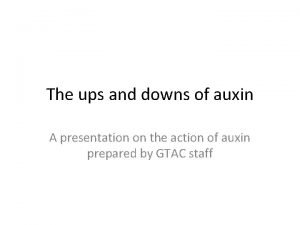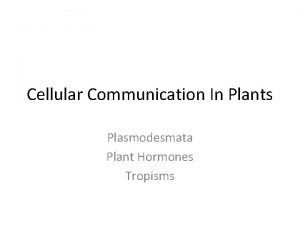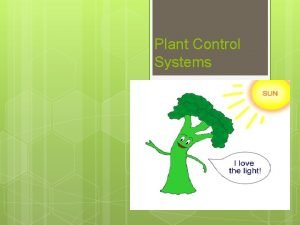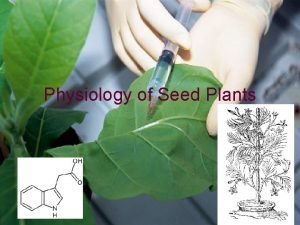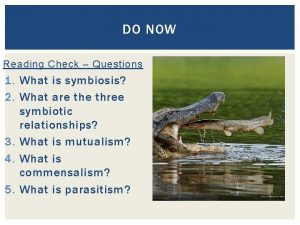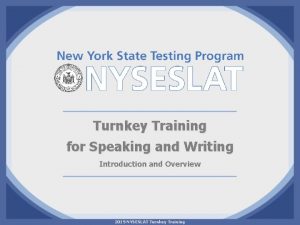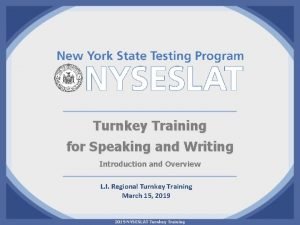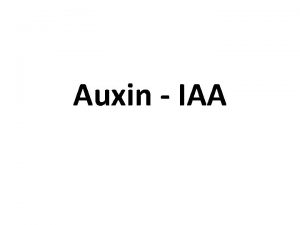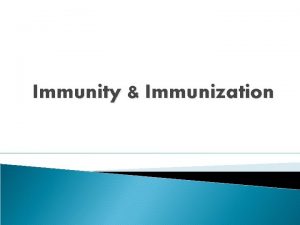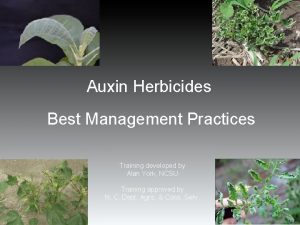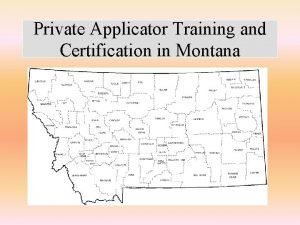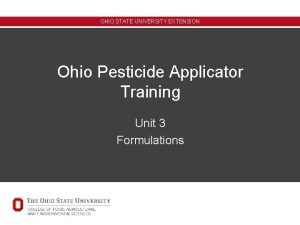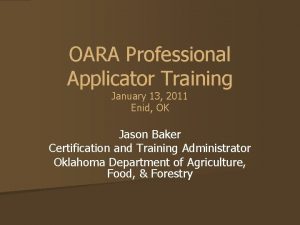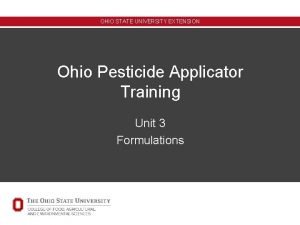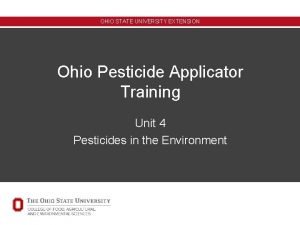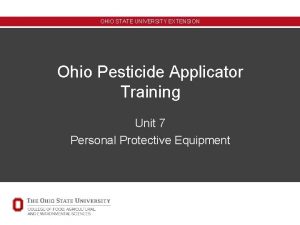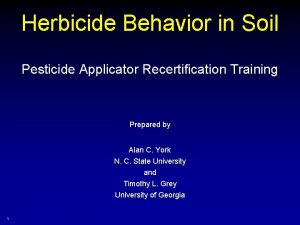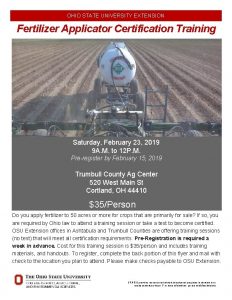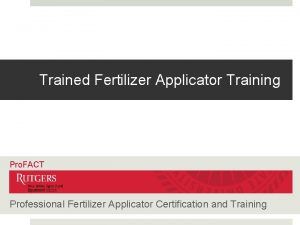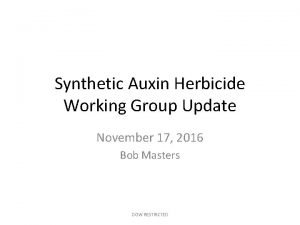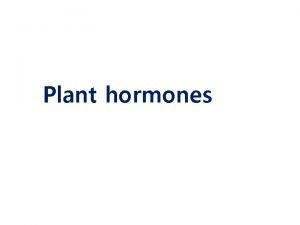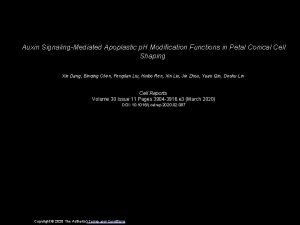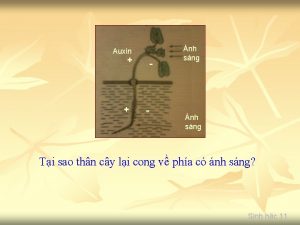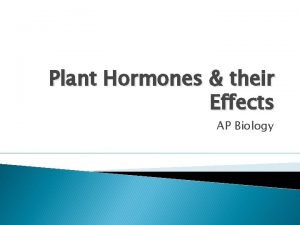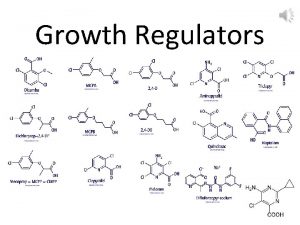2019 Auxin Specific Applicator Training and Education for
















































































- Slides: 80

2019 Auxin Specific Applicator Training and Education for use of approved dicamba and 2, 4 -D herbicides THESE TRAINING MATERIALS ARE DESIGNED TO SATISFY FEDERAL TRAINING REQUIREMENTS AND THE TRAINING AND APPLICATION REQUIREMENTS IMPOSED BY THE TEXAS DEPARTMENT OF AGRICULTURE. 01/19

Training For Approved Dicamba & 2, 4 -D Formulations § This training satisfies the § US EPA requirement for mandatory dicamba applicator training § Texas Dept Ag (TDA) requirement for auxin specific training for approved dicamba and 2, 4 -D formulations § This training is not a substitute for the state-specific Certified Applicator training which is required to purchase and use Restricted Use Pesticides § This training certifies you to use approved auxin formulations for the 2019 season only § Qualifies you for 2 CEU’s of Laws and Regs § Some restrictions subject to change pending 24 c submission THESE TRAINING MATERIALS ARE DESIGNED TO SATISFY FEDERAL TRAINING REQUIREMENTS AND THE TRAINING AND APPLICATION REQUIREMENTS IMPOSED BY THE TEXAS DEPARTMENT OF AGRICULTURE. 01/19

Training For Approved Dicamba Formulations The following dicamba formulations are approved for use on dicamba-tolerant and certain conventional crops and are covered by this training: Engenia® herbicide (BASF) • www. engeniaherbicide. com Xtendi. Max® herbicide with Vapor. Grip® Technology (Bayer) • www. xtendimaxapplicationrequirements. com Du. Pont® Fe. Xapan® herbicide Plus Vapor. Grip Technology • www. fexapanapplicationrequirements. dupont. com Any new products released in 2019 requiring auxin training • The applicator must read and follow any of those new product labels and abide by any additional application requirements that may not have been covered in the training. These products are US EPA Restricted Use Pesticides & State limited use in TX For retail sale to and use only by certified applicators. THESE TRAINING MATERIALS ARE DESIGNED TO SATISFY FEDERAL TRAINING REQUIREMENTS AND THE TRAINING AND APPLICATION REQUIREMENTS IMPOSED BY THE TEXAS DEPARTMENT OF AGRICULTURE. 01/19

Training For Approved 2, 4 -D Formulations The following 2, 4 -D formulations are approved for use on 2, 4 -D tolerant crops and certain conventional crops and are covered by this training: Enlist One™ Enlist Duo® • www. Enlist. Tank. Mix. com Always read and follow the specific product label. These products are State limited use pesticides in TX. For retail sale to and use only by certified applicators or those working under the supervision of a certified applicator. THESE TRAINING MATERIALS ARE DESIGNED TO SATISFY FEDERAL TRAINING REQUIREMENTS AND THE TRAINING AND APPLICATION REQUIREMENTS IMPOSED BY THE TEXAS DEPARTMENT OF AGRICULTURE. 01/19

Training For Approved Auxin Formulations Topics: Why do Auxin herbicides require additional precautions Label requirements for approved auxin formulations Understanding temperature inversions Spray system hygiene Record keeping Using dicamba and 2, 4 -D in a weed management system Summary THESE TRAINING MATERIALS ARE DESIGNED TO SATISFY FEDERAL TRAINING REQUIREMENTS AND THE TRAINING AND APPLICATION REQUIREMENTS IMPOSED BY THE TEXAS DEPARTMENT OF AGRICULTURE. 01/19

Training For Approved Auxin Formulations Topics: Why do Auxin herbicides require additional precautions Label requirements for approved auxin formulations Understanding temperature inversions Spray system hygiene Record keeping Using dicamba and 2, 4 -D in a weed management system Summary THESE TRAINING MATERIALS ARE DESIGNED TO SATISFY FEDERAL TRAINING REQUIREMENTS AND THE TRAINING AND APPLICATION REQUIREMENTS IMPOSED BY THE TEXAS DEPARTMENT OF AGRICULTURE. 01/19

Dicamba & 2, 4 -D are Synthetic Auxin Herbicides Synthetic auxins are very effective herbicides IAA (auxin) • Broadleaf plants (dicots) are very susceptible • Grass plants (monocots) are generally tolerant Dicamba Effect on plant growth is “systemic” Symptomology can develop at very low rates • Only affects new growth • Visual symptoms are delayed 2, 4 -D Very low rates can cause symptomology in new growth THESE TRAINING MATERIALS ARE DESIGNED TO SATISFY FEDERAL TRAINING REQUIREMENTS AND THE TRAINING AND APPLICATION REQUIREMENTS IMPOSED BY THE TEXAS DEPARTMENT OF AGRICULTURE. 01/19

Dicamba Visual Sensitivity Scale – 2018 Moderate Severe Extreme Broccoli Cabbage Kale Mustard Pecan Turnip Cantaloupe Canola* Cucumber Peach Peanut Squash Cotton Pepper Tomato Watermelon Grapes* Lima bean Snap bean Southern pea Soybean Sweet potato* Tobacco* > 1/75 X 1/75 -1/300 X 1/300 -1/800 X < 1/800 X Lower Herbicide Rate of Visually Detectable Injury Adapted from Dr. Stanley Culpepper, UGA Cooperative. *Data from literature; all other data generated in GA field studies. THESE TRAINING MATERIALS ARE DESIGNED TO SATISFY FEDERAL TRAINING REQUIREMENTS AND THE TRAINING AND APPLICATION REQUIREMENTS IMPOSED BY THE TEXAS DEPARTMENT OF AGRICULTURE. 01/19

2, 4 -D Visual Sensitivity Scale - 2018 Lower Moderate Severe Extreme Broccoli Cabbage Kale Mustard Onions Peaches Peanut Pecan Turnip Cantaloupe Canola Cucumber Soybean Squash Pepper Tomato Watermelon Cotton Grapes* Sweet potato* Tobacco* > 1/75 X 1/75 -1/300 X 1/300 -1/800 X < 1/800 X Herbicide Rate of Visually Detectable Injury Adapted from Dr. Stanley Culpepper, UGA Cooperative. *Data from literature; all other data generated in GA field studies. THESE TRAINING MATERIALS ARE DESIGNED TO SATISFY FEDERAL TRAINING REQUIREMENTS AND THE TRAINING AND APPLICATION REQUIREMENTS IMPOSED BY THE TEXAS DEPARTMENT OF AGRICULTURE. 01/19

Soybean Sensitivity To Herbicides Rate Dicamba Glufosinate Glyphosate 1/100 of field rate 1/1000 of field rate Soybeans are extremely sensitive to dicamba relative to other herbicides 2017 BASF field research trials THESE TRAINING MATERIALS ARE DESIGNED TO SATISFY FEDERAL TRAINING REQUIREMENTS AND THE TRAINING AND APPLICATION REQUIREMENTS IMPOSED BY THE TEXAS DEPARTMENT OF AGRICULTURE. 01/19

Cotton Sensitivity To Herbicides Rate Nontreated 1/1000 X 1/10 X 1 X 2, 4 -D Dicamba Cotton is much more sensitive to 2, 4 -D compared to dicamba 2014 Texas Agrilife Research Trial – 3 weeks after application - Halfway, TX **Most recent fully unfurled leaf THESE TRAINING MATERIALS ARE DESIGNED TO SATISFY FEDERAL TRAINING REQUIREMENTS AND THE TRAINING AND APPLICATION REQUIREMENTS IMPOSED BY THE TEXAS DEPARTMENT OF AGRICULTURE. 01/19

Dicamba Symptomology Other crops Cucumbers Courtesy of University of Arkansas Extension Tomatoes Courtesy of University of Arkansas Extension Grapes Courtesy of OSU Extension BASF Photo Oak trees Sweet Potatoes Dry Beans Exercise extreme care with auxin applications with nearby broadleaf crops THESE TRAINING MATERIALS ARE DESIGNED TO SATISFY FEDERAL TRAINING REQUIREMENTS AND THE TRAINING AND APPLICATION REQUIREMENTS IMPOSED BY THE TEXAS DEPARTMENT OF AGRICULTURE. 01/19

Synthetic Auxin Herbicides Summary Dicamba and 2, 4 -D are synthetic auxin herbicides Most dicot plants are very sensitive to synthetic auxin herbicides Extremely low doses (below 1% of a full rate) can cause auxin like symptoms Product labels must be carefully followed to prevent both drift to sensitive species or spray system contamination Following application requirements is critical to mitigate off-target movement THESE TRAINING MATERIALS ARE DESIGNED TO SATISFY FEDERAL TRAINING REQUIREMENTS AND THE TRAINING AND APPLICATION REQUIREMENTS IMPOSED BY THE TEXAS DEPARTMENT OF AGRICULTURE. 01/19

Training For Approved Auxin Formulations Topics: Why do Auxin herbicides require additional precautions Label requirements for approved auxin formulations Understanding temperature inversions Spray system hygiene Record keeping Using dicamba and 2, 4 -D in a weed management system Summary THESE TRAINING MATERIALS ARE DESIGNED TO SATISFY FEDERAL TRAINING REQUIREMENTS AND THE TRAINING AND APPLICATION REQUIREMENTS IMPOSED BY THE TEXAS DEPARTMENT OF AGRICULTURE. 01/19

Approved Auxin Formulations Key elements for on-target applications in auxin-tolerant crops Dicamba - Only Engenia®, Xtendimax® and Fe. Xapan® herbicides are registered for use on dicamba tolerant cotton and soybeans. 2, 4 -D - Only Enlist One™ and Enlist Duo® herbicides are registered for use on Enlist™ tolerant crops. Use of other dicamba or 2, 4 -D formulations is illegal and applicators could be subjected to significant fines by regulatory authorities. 2, 4 -D and dicamba are not cross-tolerant THESE TRAINING MATERIALS ARE DESIGNED TO SATISFY FEDERAL TRAINING REQUIREMENTS AND THE TRAINING AND APPLICATION REQUIREMENTS IMPOSED BY THE TEXAS DEPARTMENT OF AGRICULTURE. 01/19

Mechanisms of off-target movement Primary: • Wind transport of spray particles • Including temperature inversion • Tank/equipment contamination Secondary: • Water movement • Volatility Approved dicamba & 2, 4 -D formulations and label requirements address these mechanisms of off-target movement THESE TRAINING MATERIALS ARE DESIGNED TO SATISFY FEDERAL TRAINING REQUIREMENTS AND THE TRAINING AND APPLICATION REQUIREMENTS IMPOSED BY THE TEXAS DEPARTMENT OF AGRICULTURE. 01/19

Key elements for on-target applications 1. Nozzles and boom height 2. Wind speed/direction and buffers 3. Tank mixtures 4. Avoid temperature inversions 5. Spray system hygiene THESE TRAINING MATERIALS ARE DESIGNED TO SATISFY FEDERAL TRAINING REQUIREMENTS AND THE TRAINING AND APPLICATION REQUIREMENTS IMPOSED BY THE TEXAS DEPARTMENT OF AGRICULTURE. 01/19

Nozzle Selection Driftable Fines dicamba + glyphosate 0. 07 Volume frequency (%) 0. 06 Driftable Fines < 150 µm 0. 05 0. 04 0. 03 Nozzle Type 35% XR 11004 7% AIXR 11004 0. 02 <1% 0. 01 TTI 11004 0 10 10000 Droplet size (µm) Go to website of approved dicamba formulation for list of nozzles Check the Enlist product labels for approved list of nozzles THESE TRAINING MATERIALS ARE DESIGNED TO SATISFY FEDERAL TRAINING REQUIREMENTS AND THE TRAINING AND APPLICATION REQUIREMENTS IMPOSED BY THE TEXAS DEPARTMENT OF AGRICULTURE. 01/19

Nozzle Selection Requirement Nozzle Type § Use only approved nozzles within the pressure ranges listed on the specific product websites for dicamba or on the label for Enlist One and Enlist Duo. § Do not use any nozzle and pressure combination not specifically listed on the label or the specific product website. § Applicators are required to consult specific product website no more than 7 days before application for a complete list of nozzles, DRAs, and other herbicides, pesticides, and additives approved for use with dicamba. THESE TRAINING MATERIALS ARE DESIGNED TO SATISFY FEDERAL TRAINING REQUIREMENTS AND THE TRAINING AND APPLICATION REQUIREMENTS IMPOSED BY THE TEXAS DEPARTMENT OF AGRICULTURE. 01/19

Control the Controllable Effect of Droplet Size Over Fall of 10 Feet Adapted from: Ross and Lembi, 1985. *Ten foot boom height for illustrative purposes only. THESE TRAINING MATERIALS ARE DESIGNED TO SATISFY FEDERAL TRAINING REQUIREMENTS AND THE TRAINING AND APPLICATION REQUIREMENTS IMPOSED BY THE TEXAS DEPARTMENT OF AGRICULTURE. 01/19

TTI 11004 NOZZLE AT VARIABLE OPERATING PRESSURE RANGE Dicamba (0. 5 lb ae/acre) + Roundup Power. MAX® herbicide (1. 125 lb ae/acre) + DRA (0. 5% V/V) Both pressures shown below are within approved range; yet higher PSI improves coverage INCOMPLE TE PATTER N FULL PATTE RN 20 PSI 60 PSI THESE TRAINING MATERIALS ARE DESIGNED TO SATISFY FEDERAL TRAINING REQUIREMENTS AND THE TRAINING AND APPLICATION REQUIREMENTS IMPOSED BY THE TEXAS DEPARTMENT OF AGRICULTURE. 01/19

Nozzle Selection Incorrect nozzles can increase drift by 66 times* *Based on increased deposition at 110’ in AGDISP modelling comparing approved TTI 11004 vs. unapproved TT 11004 each at 60 PSI THESE TRAINING MATERIALS ARE DESIGNED TO SATISFY FEDERAL TRAINING REQUIREMENTS AND THE TRAINING AND APPLICATION REQUIREMENTS IMPOSED BY THE TEXAS DEPARTMENT OF AGRICULTURE. 01/19

Boom Height Requirement* Key for consistency of nozzle performance 24” Maximum Boom Height Above Target *dicamba required / 2, 4 -D recommended 48” height can increase drift potential by 5. 6 times** **Based on increased deposition at 110” in AGDISP modelling comparing 24” vs. 48” above target with approved TTI 11004 at 60 PSI THESE TRAINING MATERIALS ARE DESIGNED TO SATISFY FEDERAL TRAINING REQUIREMENTS AND THE TRAINING AND APPLICATION REQUIREMENTS IMPOSED BY THE TEXAS DEPARTMENT OF AGRICULTURE. 01/19

Wind Speed Requirements Apply when winds are 3 to 10 mph Wind Speed Label Requirement < 3 mph DO NOT spray 3 to 10 mph* Spray ONLY IF wind is blowing away from neighboring sensitive crops or residential areas > 10 mph DO NOT spray *Sustained wind speed, but consider potential of wind gusts based on frequency and speed of “gust”. Measure wind speed as an average over 2 minutes. Monitor wind speed and direction during application and adjust accordingly THESE TRAINING MATERIALS ARE DESIGNED TO SATISFY FEDERAL TRAINING REQUIREMENTS AND THE TRAINING AND APPLICATION REQUIREMENTS IMPOSED BY THE TEXAS DEPARTMENT OF AGRICULTURE. 01/19

Wind Speed Influence on physical spray drift Doubling wind speed (i. e. from 10 to 20 MPH) can increase potential drift by 3. 4 times* *Based increased deposition at 110” in AGDISP modelling comparing 10 vs. 20 mph with approved TTI 11004 at 60 PSI THESE TRAINING MATERIALS ARE DESIGNED TO SATISFY FEDERAL TRAINING REQUIREMENTS AND THE TRAINING AND APPLICATION REQUIREMENTS IMPOSED BY THE TEXAS DEPARTMENT OF AGRICULTURE. 01/19

Sensitive Areas and Crops Know your surroundings prior to application Survey surroundings for potential neighboring sensitive areas and crops Visit with your neighbors on their cropping plans around your fields TX does not have an active specialty crop registry (Consult sensitive crop registries for location of specialty crops and other sensitive sites) Dicamba Specific Consult www. epa. gov/espp or call 1 -844 -447 -3813 and follow any county specific dicamba use restrictions for corresponding endangered species Record areas of potential buffer zones around all edges of the field Document your efforts to identify sensitive crops Improve decision making with prior knowledge of your surroundings THESE TRAINING MATERIALS ARE DESIGNED TO SATISFY FEDERAL TRAINING REQUIREMENTS AND THE TRAINING AND APPLICATION REQUIREMENTS IMPOSED BY THE TEXAS DEPARTMENT OF AGRICULTURE. 01/19

Sensitive Areas, Sensitive Crops & Residential Areas Buffer zones and when not to spray - Dicamba Category Examples Application Requirement Sensitive Areas: Bodies of water and non-residential, uncultivated areas that may harbor sensitive plants • Native vegetation • Woodland • Bodies of water 110’ downwind buffer (0. 5 lb ae/ac) 220’ buffer (>0. 5 to 1 lb ae/ac) Sensitive Crops and Residential Areas: • Non-dicambatolerant soybeans and cotton • Fruiting vegetables (e. g. , tomatoes) • Tobacco • Grapes • Fruit trees • Homesteads DO NOT spray if these are neighboring and downwind Endangered Species Counties: 57’ buffer on remaining sides Know your surroundings before you make a dicamba application THESE TRAINING MATERIALS ARE DESIGNED TO SATISFY FEDERAL TRAINING REQUIREMENTS AND THE TRAINING AND APPLICATION REQUIREMENTS IMPOSED BY THE TEXAS DEPARTMENT OF AGRICULTURE. 01/19

Sensitive Areas and Susceptible Crops Buffer zones and when not to spray - Enlist Category Sensitive Areas: areas identified that may be potential habitat or locations of protected species Susceptible Crops Examples • Wooded areas • Pasture • Roadside ditch • Lawns and gardens • Tree Plantation • Non-2, 4 -D-tolerant cotton • Fruiting vegetables (e. g. , tomatoes) • Tobacco • Grapes • Fruit trees Application Requirement 30’ downwind buffer DO NOT spray if these are neighboring and downwind Know your surroundings before you make a 2, 4 -D application THESE TRAINING MATERIALS ARE DESIGNED TO SATISFY FEDERAL TRAINING REQUIREMENTS AND THE TRAINING AND APPLICATION REQUIREMENTS IMPOSED BY THE TEXAS DEPARTMENT OF AGRICULTURE. 01/19

Buffer Zone Requirement - Dicamba Applicators must maintain a 110 foot buffer from the downwind field edge Non-Sensitive Crops and Areas may be included as part of the buffer: 1. Roads, paved or gravel surfaces, mowed and/or managed areas adjacent to the field, such as roadside rights-of-way 2. Agriculture fields that have been prepared for planting 3. Planted Agricultural Fields to DT soybeans, DT cotton, asparagus, corn, sorghum, proso millet, small grains, and sugarcane 4. Areas covered by the footprint of a building, shade house, silo, feed crib, or other man made structure with walls and or roof Buffer zone determination is a record keeping requirement THESE TRAINING MATERIALS ARE DESIGNED TO SATISFY FEDERAL TRAINING REQUIREMENTS AND THE TRAINING AND APPLICATION REQUIREMENTS IMPOSED BY THE TEXAS DEPARTMENT OF AGRICULTURE. 01/19

Endangered Species Buffer Zone Requirement – Dicamba Some counties may potentially harbor threatened or endangered species Fields in these counties require a 110 foot downwind buffer plus a 57 foot buffer on all other sides of the field Non-Sensitive Crops and Areas may be included as part of the required buffer zones Bulletins showing these counties can be found at www. epa. gov/espp/ or call 1 -844 -447 -3813 Buffer zone determination is a record keeping requirement THESE TRAINING MATERIALS ARE DESIGNED TO SATISFY FEDERAL TRAINING REQUIREMENTS AND THE TRAINING AND APPLICATION REQUIREMENTS IMPOSED BY THE TEXAS DEPARTMENT OF AGRICULTURE. 01/19

Counties Requiring Endangered Species Buffer Zone for Dicamba Cameron Coke El Paso Fort Bend Hidalgo Jim Wells Kleberg Medina Mitchell Nueces Refugio Robertson Runnels Starr Uvalde Willacy Williamson Updated on 1/7/2019 and Valid through July 2019 THESE TRAINING MATERIALS ARE DESIGNED TO SATISFY FEDERAL TRAINING REQUIREMENTS AND THE TRAINING AND APPLICATION REQUIREMENTS IMPOSED BY THE TEXAS DEPARTMENT OF AGRICULTURE. 01/19

Buffer Zone Requirement - Enlist Applicators must maintain a 30 foot buffer from the downwind field edge Non-Sensitive Crops and Areas may be included as part of the buffer: 1. Roads, paved or gravel surfaces 2. Agriculture fields that have been prepared for planting 3. Planted Agricultural Fields to rice, peanuts, corn, sorghum, soybeans, wheat, alfalfa 4. Areas covered by the footprint of a building, shade house, silo, feed crib, or other man made structure with walls and or roof zone determination is asusceptible record keeping requirement 30 ft. buffers do. Buffer not apply to downwind crops, including non-Enlist cotton. DO NOT SPRAY when adjacent susceptible crops are downwind. THESE TRAINING MATERIALS ARE DESIGNED TO SATISFY FEDERAL TRAINING REQUIREMENTS AND THE TRAINING AND APPLICATION REQUIREMENTS IMPOSED BY THE TEXAS DEPARTMENT OF AGRICULTURE. 01/19

Sensitive Crops and Residential Areas DO NOT apply where spray drift may occur to food, forage or other plantings DO NOT apply when wind is blowing in the direction of neighboring sensitive crops or residential areas It is up to the applicator to use proper judgement to decide what field is “neighboring” and thereby susceptible to drift Avoiding spray drift at the application site is the responsibility of the applicator THESE TRAINING MATERIALS ARE DESIGNED TO SATISFY FEDERAL TRAINING REQUIREMENTS AND THE TRAINING AND APPLICATION REQUIREMENTS IMPOSED BY THE TEXAS DEPARTMENT OF AGRICULTURE. 01/19

Spray Buffer Requirements Example of no in-field buffer required (non-endangered species county) North Wind 3 to 10 MPH Corn (a non-sensitive crop) counts as part of the 110’ downwind buffer No in-field buffer needed Corn Non-Dicamba Tolerant Cotton Corn Avoiding spray drift at the application site is the responsibility of the applicator THESE TRAINING MATERIALS ARE DESIGNED TO SATISFY FEDERAL TRAINING REQUIREMENTS AND THE TRAINING AND APPLICATION REQUIREMENTS IMPOSED BY THE TEXAS DEPARTMENT OF AGRICULTURE. 01/19 Tree line

Application Decisions Example of in-field buffer required (non-endangered species county) Northwest Wind 3 to 10 MPH Corn Non-Dicamba Tolerant Cotton The sensitive area (tree line) requires a 110’ downwind buffer to the east Corn (a non-sensitive crop) counts as part of the 110’ downwind buffer to the south Dicamba Tolerant Cotton Corn Avoiding spray drift at the application site is the responsibility of the applicator THESE TRAINING MATERIALS ARE DESIGNED TO SATISFY FEDERAL TRAINING REQUIREMENTS AND THE TRAINING AND APPLICATION REQUIREMENTS IMPOSED BY THE TEXAS DEPARTMENT OF AGRICULTURE. 01/19 Tree line

Application Decisions Example of when not to spray DO NOT spray with neighboring sensitive crops downwind (e. g. Non-Dicamba Tolerant Cotton) Southwest Wind 3 to 10 MPH Corn Non-Dicamba Tolerant Cotton Corn Avoiding spray drift at the application site is the responsibility of the applicator THESE TRAINING MATERIALS ARE DESIGNED TO SATISFY FEDERAL TRAINING REQUIREMENTS AND THE TRAINING AND APPLICATION REQUIREMENTS IMPOSED BY THE TEXAS DEPARTMENT OF AGRICULTURE. 01/19

Spray Buffer Requirements When not to spray Northwest Wind 3 to 10 MPH Non-Dicamba Tolerant Cotton DO NOT spray with neighboring sensitive crop exists downwind just past the sensitive area Dicamba Tolerant Cotton Corn Consider your surroundings – not every field should be sprayed with dicamba THESE TRAINING MATERIALS ARE DESIGNED TO SATISFY FEDERAL TRAINING REQUIREMENTS AND THE TRAINING AND APPLICATION REQUIREMENTS IMPOSED BY THE TEXAS DEPARTMENT OF AGRICULTURE. 01/19 Tree line

Spray Buffer Requirements When not to spray West Wind 3 to 10 MPH Corn Non-Dicamba Tolerant Cotton Slight variation in wind direction will result in downwind sensitive crops and a DO NOT SPRAY situation Dicamba Tolerant Cotton Non-Dicamba Tolerant Cotton Consider your surroundings – not every field should be sprayed with dicamba THESE TRAINING MATERIALS ARE DESIGNED TO SATISFY FEDERAL TRAINING REQUIREMENTS AND THE TRAINING AND APPLICATION REQUIREMENTS IMPOSED BY THE TEXAS DEPARTMENT OF AGRICULTURE. 01/19 Tree line

Spray Buffer Requirements For Endangered Species Counties Non-Dicamba Tolerant Cotton Northwest Wind 3 to 10 MPH Non-Dicamba Tolerant Cotton 110’ downwind buffer adjacent to sensitive areas on east and south Maintained road ditches and roads count as part of the 57’ buffers on the north and west No in-field buffers needed there Corn 110’ buffer Dicamba Tolerant Cotton Sensitive Area Corn Avoiding spray drift at the application site is the responsibility of the applicator THESE TRAINING MATERIALS ARE DESIGNED TO SATISFY FEDERAL TRAINING REQUIREMENTS AND THE TRAINING AND APPLICATION REQUIREMENTS IMPOSED BY THE TEXAS DEPARTMENT OF AGRICULTURE. 01/19

Spray Buffer Requirements For Endangered Species Non-Dicamba Tolerant Cotton Northeast Wind 3 to 10 MPH Non-Dicamba Tolerant Cotton 110’ downwind buffer adjacent to sensitive areas on south 57’ buffer next to sensitive area on east Maintained road ditches and road count as part of the 57’ buffers on the north Maintained road ditches, road, and non-sensitive areas count part of the 110’ downwind buffer to the west Corn 57’ buffer Dicamba Tolerant Cotton Sensitive Area Corn 110’’ buffer Additional state restrictions may apply Avoiding spray drift at the application site is the responsibility of the applicator THESE TRAINING MATERIALS ARE DESIGNED TO SATISFY FEDERAL TRAINING REQUIREMENTS AND THE TRAINING AND APPLICATION REQUIREMENTS IMPOSED BY THE TEXAS DEPARTMENT OF AGRICULTURE. 01/19

Should you spray? Wind blowing from the west to the east at 8 mph Enlist Cotton Peanuts WIND THESE TRAINING MATERIALS ARE DESIGNED TO SATISFY FEDERAL TRAINING REQUIREMENTS AND THE TRAINING AND APPLICATION REQUIREMENTS IMPOSED BY THE TEXAS DEPARTMENT OF AGRICULTURE. 01/19

Should you spray? Wind blowing from the west to the east at 10 mph Enlist Cotton 1 Enlist Cotton 2 Non Enlist Cotton WIND THESE TRAINING MATERIALS ARE DESIGNED TO SATISFY FEDERAL TRAINING REQUIREMENTS AND THE TRAINING AND APPLICATION REQUIREMENTS IMPOSED BY THE TEXAS DEPARTMENT OF AGRICULTURE. 01/19

Should you spray? WIND Wind blowing from the south into the north at 8 mph Although the field prepared for planting is not a susceptible crop for Enlist herbicides, use caution when wind is blowing parallel to non-Enlist cotton. Recommendation in this scenario is to wait until wind is blowing away from the susceptible crop. Enlist Cotton 1 Enlist Cotton 2 Non Enlist Cotton THESE TRAINING MATERIALS ARE DESIGNED TO SATISFY FEDERAL TRAINING REQUIREMENTS AND THE TRAINING AND APPLICATION REQUIREMENTS IMPOSED BY THE TEXAS DEPARTMENT OF AGRICULTURE. 01/19

Beware - buffers do not apply to downwind susceptible crops, such as cotton without the herbicide trait. Sorghum Neighboring susc. crop 50 ft ditchbank Susceptible crops examples Cotton without herbicide trait Grapes Cucurbits Fruiting Vegetables Area sprayed Tomatoes Tobacco THESE TRAINING MATERIALS ARE DESIGNED TO SATISFY FEDERAL TRAINING REQUIREMENTS AND THE TRAINING AND APPLICATION REQUIREMENTS IMPOSED BY THE TEXAS DEPARTMENT OF AGRICULTURE. 01/19

Tank Mixtures Only use products approved by the EPA Consult respective websites for list of approved tank-mix partners • Engenia® herbicide: www. Engenia. Tank. Mix. com • Xtendimax® herbicide: www. xtendimaxapplicationrequirements. com • Fe. Xapan® herbicide: www. fexapanapplicationrequirements. dupont. com • Enlist One™ & Enlist Duo®: www. Enlist. Tank. Mix. com Use approved DRA if required NO ammonium salts (AMS, UAN) or acidifying water conditioners - Dicamba • Tank must be cleaned prior to mixing so that no AMS or UAN residues remain These restrictions apply to all conventional and HT crop uses THESE TRAINING MATERIALS ARE DESIGNED TO SATISFY FEDERAL TRAINING REQUIREMENTS AND THE TRAINING AND APPLICATION REQUIREMENTS IMPOSED BY THE TEXAS DEPARTMENT OF AGRICULTURE. 01/19

Tank Mixtures – Dicamba Only Impact of AMS on dicamba volatility 8 Dicamba Loss (%) BASF Lab Study Engenia herbicide: 12. 8 fl oz/A Engenia AMS – 0. 5% w/v at+ 10 GPA Test Conditions: 6 Duration: 24 hours + AMS Air flow: 0. 5 l/min using 2. 5 l tank 4 RH: 35% Substrate: glass 2 0 dicamba herbicide Alone 72 22 75 24 79 26 82 28 86 30 90 32 93 34 97 36 100 38 ◦F) Temperature ((C) Temperature AMS increases potential volatility by 20 times THESE TRAINING MATERIALS ARE DESIGNED TO SATISFY FEDERAL TRAINING REQUIREMENTS AND THE TRAINING AND APPLICATION REQUIREMENTS IMPOSED BY THE TEXAS DEPARTMENT OF AGRICULTURE. 01/19

Tank Mixtures – Dicamba Only Solution p. H Spray solutions with p. H levels less than 5 may increase the potential volatility of dicamba Litmus paper and p. H meters can help determine the final solution p. H Water source and/or tank-mixtures may impact final solution p. H Neutral buffering agents can be added if listed on www. engeniatankmix. com DO NOT use ammonium containing products or acidifying water conditioners THESE TRAINING MATERIALS ARE DESIGNED TO SATISFY FEDERAL TRAINING REQUIREMENTS AND THE TRAINING AND APPLICATION REQUIREMENTS IMPOSED BY THE TEXAS DEPARTMENT OF AGRICULTURE. 01/19

Crop Specific Directions Applications to Cotton - Enlist Cotto n Approved 2, 4 -D formulations can be made up to mid bloom MAXIMUM OF TWO IN- CROP APPLICATIONS THESE TRAINING MATERIALS ARE DESIGNED TO SATISFY FEDERAL TRAINING REQUIREMENTS AND THE TRAINING AND APPLICATION REQUIREMENTS IMPOSED BY THE TEXAS DEPARTMENT OF AGRICULTURE. 01/19

Crop Specific Directions Applications to Cotton - Dicamba Cotto n Approved dicamba formulations can be made up to 60 days after planting or mid bloom, whichever occurs first MAXIMUM OF TWO IN- CROP APPLICATIONS THESE TRAINING MATERIALS ARE DESIGNED TO SATISFY FEDERAL TRAINING REQUIREMENTS AND THE TRAINING AND APPLICATION REQUIREMENTS IMPOSED BY THE TEXAS DEPARTMENT OF AGRICULTURE. 01/19

Crop Specific Directions Applications to Soybean - Dicamba Soybe an Approved dicamba formulations can be made up to 45 days after planting or prior to first bloom, whichever occurs first MAXIMUM OF TWO IN - CROP APPLICATIONS R 1 G R O W TH S T A G E I N S O Y B E A N S = B E G I N N I N G B L O O M ( O P E N F L O W E R A T A N Y N O D E O N T HE MAIN STEM) THESE TRAINING MATERIALS ARE DESIGNED TO SATISFY FEDERAL TRAINING REQUIREMENTS AND THE TRAINING AND APPLICATION REQUIREMENTS IMPOSED BY THE TEXAS DEPARTMENT OF AGRICULTURE. 01/19

Restrictions Highlighted Label Requirements Minimum application volume: 15 GPA for dicamba 10 -15 GPA for Enlist Sprayer speed: ≤ 15 mph Rainfall: DO NOT apply if expected rainfall within 24 hours after application will result in runoff – dicamba specific • Rainfast: 4 hours DO NOT apply aerially THESE TRAINING MATERIALS ARE DESIGNED TO SATISFY FEDERAL TRAINING REQUIREMENTS AND THE TRAINING AND APPLICATION REQUIREMENTS IMPOSED BY THE TEXAS DEPARTMENT OF AGRICULTURE. 01/19

Training For Approved Dicamba Formulations Topics: Why does dicamba require additional precautions Label requirements for approved dicamba formulations Understanding temperature inversions Spray system hygiene Record keeping Using dicamba in a weed management system Summary THESE TRAINING MATERIALS ARE DESIGNED TO SATISFY FEDERAL TRAINING REQUIREMENTS AND THE TRAINING AND APPLICATION REQUIREMENTS IMPOSED BY THE TEXAS DEPARTMENT OF AGRICULTURE. 01/19

Avoid Temperature Inversions DO NOT apply when temperature inversions exist at the field level • Temperature inversions occur when temperatures increase with altitude • Presence often indicated by ground fog, smoke not rising, dust hanging over a road, or presence of dew or frost ONLY apply Dicamba from one hour after sunrise until two hours before sunset Confirm that field level inversions DO NOT exist before application THESE TRAINING MATERIALS ARE DESIGNED TO SATISFY FEDERAL TRAINING REQUIREMENTS AND THE TRAINING AND APPLICATION REQUIREMENTS IMPOSED BY THE TEXAS DEPARTMENT OF AGRICULTURE. 01/19

Temperature Inversions Impact on physical spray drift During an inversion small droplets remain suspended in air and move great distances horizontality for as long as inversion lasts Larger area potentially impacted Symptomology possible over large area Direction & distance of movement is unpredictable DO NOT make applications when an inversion exists at the field level THESE TRAINING MATERIALS ARE DESIGNED TO SATISFY FEDERAL TRAINING REQUIREMENTS AND THE TRAINING AND APPLICATION REQUIREMENTS IMPOSED BY THE TEXAS DEPARTMENT OF AGRICULTURE. 01/19

Training For Approved Auxin Formulations Topics: Why do Auxin herbicides require additional precautions Label requirements for approved auxin formulations Understanding temperature inversions Spray system hygiene Record keeping Using dicamba and 2, 4 -D in a weed management system Summary THESE TRAINING MATERIALS ARE DESIGNED TO SATISFY FEDERAL TRAINING REQUIREMENTS AND THE TRAINING AND APPLICATION REQUIREMENTS IMPOSED BY THE TEXAS DEPARTMENT OF AGRICULTURE. 01/19

Spray System Hygiene 2019 US EPA requirements Spray equipment must be thoroughly cleaned before and after application of approved auxin formulations Document that required cleanout procedures were followed (dicamba) • Date and method at minimum Triple rinse procedure outlined on the label • Use detergent based tank cleaner in 2 nd rinse • Wash the exterior of the sprayer • Remove and clean end caps, nozzles, screens, and filters Hygiene is critical at all points in the handling and mixing process THESE TRAINING MATERIALS ARE DESIGNED TO SATISFY FEDERAL TRAINING REQUIREMENTS AND THE TRAINING AND APPLICATION REQUIREMENTS IMPOSED BY THE TEXAS DEPARTMENT OF AGRICULTURE. 01/19

Why focus on hygiene of the entire handling process of pesticides? Contamination can damage susceptible crops • Potential to affect multiple fields • Patterns may or may not be visible Contamination cause incompatibility and plug screens and/or other sprayer parts Contamination with ammonium sulfate (AMS) can compromise lower volatility improvements of new dicamba formulations THESE TRAINING MATERIALS ARE DESIGNED TO SATISFY FEDERAL TRAINING REQUIREMENTS AND THE TRAINING AND APPLICATION REQUIREMENTS IMPOSED BY THE TEXAS DEPARTMENT OF AGRICULTURE. 01/19

1/20, 000 th of the 1 x Use Rate (0. 000025 lb ae/A dicamba) – 14 days after vegetative stages (V 3) application on nondicamba tolerant soybeans CONTROL - 14 DAT 0. 000025 lb ae/a - 14 DAT THESE TRAINING MATERIALS ARE DESIGNED TO SATISFY FEDERAL TRAINING REQUIREMENTS AND THE TRAINING AND APPLICATION REQUIREMENTS IMPOSED BY THE TEXAS DEPARTMENT OF AGRICULTURE. 01/19

How much dicamba does it take to potentially contaminate a sprayer? 3 ml of formulated product 12 fl oz of spray solution Commercial sprayer with 1000 gallon tank Application volume: 10 GPA Hygiene is critical to preventing spray system contamination THESE TRAINING MATERIALS ARE DESIGNED TO SATISFY FEDERAL TRAINING REQUIREMENTS AND THE TRAINING AND APPLICATION REQUIREMENTS IMPOSED BY THE TEXAS DEPARTMENT OF AGRICULTURE. 01/19

Simple Handling and Mixing Model Limited points of potential contamination Product mixed directly in sprayer Product applied If there is no “upstream” product handling, then the sprayer is sole source of contamination concern THESE TRAINING MATERIALS ARE DESIGNED TO SATISFY FEDERAL TRAINING REQUIREMENTS AND THE TRAINING AND APPLICATION REQUIREMENTS IMPOSED BY THE TEXAS DEPARTMENT OF AGRICULTURE. 01/19

“Upstream” Handling and Mixing Multiple points of potential contamination Storage tanks/shuttles Hoses and pumps at the “shed” and in the field • Especially unlined EPDM hoses Mixing and loading equipment Nurse trucks Any thing formulated product and/or spray solution touches prior to the sprayer can be a source of contamination THESE TRAINING MATERIALS ARE DESIGNED TO SATISFY FEDERAL TRAINING REQUIREMENTS AND THE TRAINING AND APPLICATION REQUIREMENTS IMPOSED BY THE TEXAS DEPARTMENT OF AGRICULTURE. 01/19

Spray System Hygiene Summary Spray equipment must be thoroughly cleaned before and after application of approved dicamba or 2, 4 -D products Ensure all pumps, hoses, tanks, and other mixing and loading equipment are thoroughly cleaned before using that equipment for susceptible crops Consider having dedicated system for all equipment used in measuring, mixing, loading, and applying dicamba or 2, 4 -D products Hygiene is critical at all points in the handling and mixing process THESE TRAINING MATERIALS ARE DESIGNED TO SATISFY FEDERAL TRAINING REQUIREMENTS AND THE TRAINING AND APPLICATION REQUIREMENTS IMPOSED BY THE TEXAS DEPARTMENT OF AGRICULTURE. 01/19

Training For Approved Auxin Formulations Topics: Why do Auxin herbicides require additional precautions Label requirements for approved auxin formulations Understanding temperature inversions Spray system hygiene Record keeping Using dicamba and 2, 4 -D in a weed management system Summary THESE TRAINING MATERIALS ARE DESIGNED TO SATISFY FEDERAL TRAINING REQUIREMENTS AND THE TRAINING AND APPLICATION REQUIREMENTS IMPOSED BY THE TEXAS DEPARTMENT OF AGRICULTURE. 01/19

Record Keeping – Dicamba 2019 US EPA & TX requirements Engenia, Fexapan, and Xtendimax herbicides are Restricted Use Pesticides (RUP) New for 2019: Only Certified Applicators may purchase and apply Engenia, Fexapan, and Xtendimax herbicides State Limited Use Pesticide - TX THESE TRAINING MATERIALS ARE DESIGNED TO SATISFY FEDERAL TRAINING REQUIREMENTS AND THE TRAINING AND APPLICATION REQUIREMENTS IMPOSED BY THE TEXAS DEPARTMENT OF AGRICULTURE. 01/19

Record Keeping - Dicamba 2019 US EPA requirements Record keeping of all applications is required Records must be generated as soon as practical but no later than 72 hours after application Records must be retained for 2 years Records must be kept by field as defined by borders • If you move to a new field with different borders, new records must be kept Must be made available upon request to State Pesticide Control Officials, USDA, and/or EPA All required records per 7 CFR Part 110 Refer to federal label for full listing of record keeping requirements Paper and electronic forms will be provided to ease recording of information THESE TRAINING MATERIALS ARE DESIGNED TO SATISFY FEDERAL TRAINING REQUIREMENTS AND THE TRAINING AND APPLICATION REQUIREMENTS IMPOSED BY THE TEXAS DEPARTMENT OF AGRICULTURE. 01/19

Record Keeping - Dicamba Details that must be recorded 1. Certified applicator full name 2. Certification number 3. Product name 4. EPA registration number 5. Total amount applied 6. Application month, day, year 7. Crop planting date 8. Start and finish times 9. Location of application 10. Crop or site receiving the application 17. Buffer distance calculation 12. Applicator proof of training 18. Date and procedure for spray system cleanout (before and after spraying) 13. Application timing (PRE or days after planting) 19. List of tank-mix products with EPA registration numbers 14. Receipts of purchase 20. Nozzle and pressure 15. Product label(s) including 24(c) state local needs 21. Air temperature at boom height at start and finish 16. Document awareness of sensitive crops 22. Wind speed and direction at start and finish 11. Size of area treated Record must be made for each application of approved dicamba products THESE TRAINING MATERIALS ARE DESIGNED TO SATISFY FEDERAL TRAINING REQUIREMENTS AND THE TRAINING AND APPLICATION REQUIREMENTS IMPOSED BY THE TEXAS DEPARTMENT OF AGRICULTURE. 01/19

Record Keeping - Enlist 2019 US EPA & TX requirements Enlist One and Enlist Duo herbicides are State Limited Use Pesticides New for 2019: Only Certified Applicators and operators may purchase, but must also receive auxin training to apply. State Limited Use Pesticide - TX THESE TRAINING MATERIALS ARE DESIGNED TO SATISFY FEDERAL TRAINING REQUIREMENTS AND THE TRAINING AND APPLICATION REQUIREMENTS IMPOSED BY THE TEXAS DEPARTMENT OF AGRICULTURE. 01/19

Record Keeping - Enlist Details that must be recorded THESE TRAINING MATERIALS ARE DESIGNED TO SATISFY FEDERAL TRAINING REQUIREMENTS AND THE TRAINING AND APPLICATION REQUIREMENTS IMPOSED BY THE TEXAS DEPARTMENT OF AGRICULTURE. 01/19

Training For Approved Auxin Formulations Topics: Why do Auxin herbicides require additional precautions Label requirements for approved auxin formulations Understanding temperature inversions Spray system hygiene Record keeping Using dicamba and 2, 4 -D in a weed management system Summary THESE TRAINING MATERIALS ARE DESIGNED TO SATISFY FEDERAL TRAINING REQUIREMENTS AND THE TRAINING AND APPLICATION REQUIREMENTS IMPOSED BY THE TEXAS DEPARTMENT OF AGRICULTURE. 01/19

Effective Weed Management Key strategies Identify the target weeds Include multiple, effective sites of action (SOA) Use a good residual PRE herbicide Spray your POST herbicide early • 4“ max weed height • Target application at 3 to 5 weeks after planting for soybeans or sooner for cotton 1 • Add a residual herbicide to the POST 1 Additional state restrictions may apply. Tailor your weed management plan to the field THESE TRAINING MATERIALS ARE DESIGNED TO SATISFY FEDERAL TRAINING REQUIREMENTS AND THE TRAINING AND APPLICATION REQUIREMENTS IMPOSED BY THE TEXAS DEPARTMENT OF AGRICULTURE. 01/19

Effective Weed Management Palmer amaranth and waterhemp can grow fast! Start with a good residual PRE herbicide Plan to spray POST when weeds are <1 inch tall Minimizes weed competition and impact on crop yield 8” 4” 2” 5” Weeds, especially pigweed species, grow fast! THESE TRAINING MATERIALS ARE DESIGNED TO SATISFY FEDERAL TRAINING REQUIREMENTS AND THE TRAINING AND APPLICATION REQUIREMENTS IMPOSED BY THE TEXAS DEPARTMENT OF AGRICULTURE. 01/19

Effective Weed Management Use residual herbicide at planting POST ONLY (V 3): Engenia® herbicide (12. 8 fl oz) + glyphosate 2016 – BASF Trial – 30 Days After Post – Story City, IA PRE: Zidua® PRO herbicide (6 fl oz) POST (V 3): Engenia herbicide (12. 8 fl oz) + glyphosate PRE residual followed by POST dicamba preserves yield potential Always read and follow label directions. Engenia is a US EPA Restricted Use Pesticide. THESE TRAINING MATERIALS ARE DESIGNED TO SATISFY FEDERAL TRAINING REQUIREMENTS AND THE TRAINING AND APPLICATION REQUIREMENTS IMPOSED BY THE TEXAS DEPARTMENT OF AGRICULTURE. 01/19

Effective Weed Management Best practices to optimize efficacy Required minimum spray volume – 15 GPA 2017 BASF Spray Chamber Results • Better coverage for tough weeds • Match nozzle to GPA, pressure, and sprayer speed as specified by the label Use an adjuvant, such as a NIS 10 GPA TTI 11003 at 40 PSI • Maximizes herbicide uptake • Add approved Drift Reduction Agent (DRA) if required as listed on website for approved dicamba formulation Plan an early post application 15 GPA TTI 11004 at 40 PSI Engenia® herbicide + glyphosate + adjuvant Optimize efficacy with proper application volume and adjuvant Always read and follow label directions. Engenia is a US EPA Restricted Use Pesticide. THESE TRAINING MATERIALS ARE DESIGNED TO SATISFY FEDERAL TRAINING REQUIREMENTS AND THE TRAINING AND APPLICATION REQUIREMENTS IMPOSED BY THE TEXAS DEPARTMENT OF AGRICULTURE. 01/19

Effective Weed Management Success requires a plan Use Multiple effective Sites-of-Action • Reduce potential for development of weed resistance Use Preemergence Residual herbicides • Reduce weed pressure for better control with POST herbicides • More time to select the proper spray day for POST • Preserve yield potential Plan an Early Post treatment with a residual herbicide • Reliable control of small weeds • Extended in-season control Tailor your weed management plan to each field THESE TRAINING MATERIALS ARE DESIGNED TO SATISFY FEDERAL TRAINING REQUIREMENTS AND THE TRAINING AND APPLICATION REQUIREMENTS IMPOSED BY THE TEXAS DEPARTMENT OF AGRICULTURE. 01/19

Training For Approved Auxin Formulations Topics: Why do Auxin herbicides require additional precautions Label requirements for approved auxin formulations Understanding temperature inversions Spray system hygiene Record keeping Using dicamba and 2, 4 -D in a weed management system Summary THESE TRAINING MATERIALS ARE DESIGNED TO SATISFY FEDERAL TRAINING REQUIREMENTS AND THE TRAINING AND APPLICATION REQUIREMENTS IMPOSED BY THE TEXAS DEPARTMENT OF AGRICULTURE. 01/19

2019 requirements for on-target applications Dicamba 1 Nozzle Enlist 2 Go to herbicide website 1 or label 2 for list of approved nozzles and pressures Wind Speed Tank Mixtures/ Additives 3 to 10 mph Go to herbicide website for updated list NO ammonium salts or acidifying water conditioners (AMS or UAN) No restrictions for using AMS Ground Speed < 15 mph recommended Boom Height < 24 inches to spray target Consult nozzle manufacturer < 24 inches recommended Application Volume 15 GPA minimum 10 -15 GPA minimum THESE TRAINING MATERIALS ARE DESIGNED TO SATISFY FEDERAL TRAINING REQUIREMENTS AND THE TRAINING AND APPLICATION REQUIREMENTS IMPOSED BY THE TEXAS DEPARTMENT OF AGRICULTURE. 01/19

2019 requirements for on-target applications Dicamba 1 Enlist 2 DO NOT spray if wind is blowing toward neighboring sensitive 1/susceptible 2 crops Sensitive 1 / Susceptible 2 Crops and Residential Areas Includes non-dicamba tolerant Includes non-enlist cotton soybeans 110’ downwind buffer to nonresidential, uncultivated areas or 30’ downwind buffer to bodies of water. Sensitive Areas wooded areas, pasture, lawns, roadside ditch 57’ omni-directional buffer in EPA endangered species counties. Soybeans: Up to 45 DAP or beg. bloom Timing Cotton: up to mid-bloom (whichever comes first) Cotton: Up to 60 DAP or midbloom Weed Height 4 inches or less for best performance 4 -6 inches THESE TRAINING MATERIALS ARE DESIGNED TO SATISFY FEDERAL TRAINING REQUIREMENTS AND THE TRAINING AND APPLICATION REQUIREMENTS IMPOSED BY THE TEXAS DEPARTMENT OF AGRICULTURE. 01/19

2019 requirements for on-target applications Dicamba Training Sprayer Cleanout Temperature Inversions Daytime Applications Rainfall Record Keeping Enlist Complete annual auxin-specific training Triple rinse – use detergent based cleaner before & after application DO NOT apply during a field level temperature inversion Only apply one hour after sunrise until Don’t apply during inversion two hours before sunset DO NOT apply w/in 24 hrs of expected Don’t allow runoff rainfall – runoff potential Including application, tank TX Dept of Ag cleanout, planting date, and buffer Requirement zone calculation information No Aerial Applications THESE TRAINING MATERIALS ARE DESIGNED TO SATISFY FEDERAL TRAINING REQUIREMENTS AND THE TRAINING AND APPLICATION REQUIREMENTS IMPOSED BY THE TEXAS DEPARTMENT OF AGRICULTURE. 01/19

Training for Approved Auxin Formulations Summary of application requirements Additional state restrictions may apply Use residual herbicides at-planting Plan to spray early post Know your surroundings Know the weather conditions Follow label directions for application success Clean the spray system before and after application Handling and applying dicamba requires extra caution and attention Failure to follow any of the label requirements can lead to off-target movement DO NOT use these herbicides if you are unwilling or unable to follow requirements Always read and follow label directions. Engenia, Xtendimax, and Fe. Xapan are US EPA Restricted Use Pesticides. THESE TRAINING MATERIALS ARE DESIGNED TO SATISFY FEDERAL TRAINING REQUIREMENTS AND THE TRAINING AND APPLICATION REQUIREMENTS IMPOSED BY THE TEXAS DEPARTMENT OF AGRICULTURE. 01/19

Additional Information Engenia® herbicide from BASF • www. engeniastewardship. com • www. engeniaherbicide. com • Tank-mixtures: www. engeniatankmix. com Xtendi. Max® herbicide with Vapor. Grip® Technology • www. xtendimaxapplicationrequirements. com Du. Pont® Fe. Xapan® herbicide Plus Vapor. Grip Technology • www. fexapanapplicationrequirements. dupont. com Enlist One™ & Enlist Duo® • www. Enlist. Tank. Mix. com 24 c Update on TDA Website www. texasagriculture. gov/Regulatory. Programs/Pesticides THESE TRAINING MATERIALS ARE DESIGNED TO SATISFY FEDERAL TRAINING REQUIREMENTS AND THE TRAINING AND APPLICATION REQUIREMENTS IMPOSED BY THE TEXAS DEPARTMENT OF AGRICULTURE. 01/19
 Rotary cutting instruments in operative dentistry
Rotary cutting instruments in operative dentistry Wisconsin pesticide applicator license
Wisconsin pesticide applicator license Mica plate auxin
Mica plate auxin Xylem heat exchanger
Xylem heat exchanger Macronutrients and micronutrients in plants
Macronutrients and micronutrients in plants Elongation plant
Elongation plant Functions of auxin
Functions of auxin Response to gravity
Response to gravity Auxin effects
Auxin effects 4 tropisms
4 tropisms Auxin transport
Auxin transport Tape worm
Tape worm Specific weight
Specific weight Specific gravity pharmacy
Specific gravity pharmacy Nyseslat speaking scoring sheet
Nyseslat speaking scoring sheet Nyseslat turnkey training 2019
Nyseslat turnkey training 2019 Education pays 2019
Education pays 2019 Keeping children safe in education 2019
Keeping children safe in education 2019 Kontinuitetshantering i praktiken
Kontinuitetshantering i praktiken Typiska drag för en novell
Typiska drag för en novell Nationell inriktning för artificiell intelligens
Nationell inriktning för artificiell intelligens Vad står k.r.å.k.a.n för
Vad står k.r.å.k.a.n för Shingelfrisyren
Shingelfrisyren En lathund för arbete med kontinuitetshantering
En lathund för arbete med kontinuitetshantering Adressändring ideell förening
Adressändring ideell förening Tidbok för yrkesförare
Tidbok för yrkesförare A gastrica
A gastrica Densitet vatten
Densitet vatten Datorkunskap för nybörjare
Datorkunskap för nybörjare Boverket ka
Boverket ka Hur skriver man en debattartikel
Hur skriver man en debattartikel Delegerande ledarstil
Delegerande ledarstil Nyckelkompetenser för livslångt lärande
Nyckelkompetenser för livslångt lärande Påbyggnader för flakfordon
Påbyggnader för flakfordon Tryck formel
Tryck formel Svenskt ramverk för digital samverkan
Svenskt ramverk för digital samverkan Kyssande vind analys
Kyssande vind analys Presentera för publik crossboss
Presentera för publik crossboss Vad är ett minoritetsspråk
Vad är ett minoritetsspråk Plats för toran ark
Plats för toran ark Klassificeringsstruktur för kommunala verksamheter
Klassificeringsstruktur för kommunala verksamheter Fimbrietratt
Fimbrietratt Claes martinsson
Claes martinsson Centrum för kunskap och säkerhet
Centrum för kunskap och säkerhet Lågenergihus nyproduktion
Lågenergihus nyproduktion Mat för idrottare
Mat för idrottare Verktyg för automatisering av utbetalningar
Verktyg för automatisering av utbetalningar Rutin för avvikelsehantering
Rutin för avvikelsehantering Smärtskolan kunskap för livet
Smärtskolan kunskap för livet Ministerstyre för och nackdelar
Ministerstyre för och nackdelar Tack för att ni har lyssnat
Tack för att ni har lyssnat Hur ser ett referat ut
Hur ser ett referat ut Redogör för vad psykologi är
Redogör för vad psykologi är Stål för stötfångarsystem
Stål för stötfångarsystem Tack för att ni har lyssnat
Tack för att ni har lyssnat Borra hål för knoppar
Borra hål för knoppar Vilken grundregel finns det för tronföljden i sverige?
Vilken grundregel finns det för tronföljden i sverige? Beräkna standardavvikelse
Beräkna standardavvikelse Tack för att ni har lyssnat
Tack för att ni har lyssnat Steg för steg rita
Steg för steg rita Vad är verksamhetsanalys
Vad är verksamhetsanalys Tobinskatten för och nackdelar
Tobinskatten för och nackdelar Blomman för dagen drog
Blomman för dagen drog Modell för handledningsprocess
Modell för handledningsprocess Egg för emanuel
Egg för emanuel Elektronik för barn
Elektronik för barn Klädsel i rom
Klädsel i rom Strategi för svensk viltförvaltning
Strategi för svensk viltförvaltning Kung dog 1611
Kung dog 1611 Ellika andolf
Ellika andolf Romarriket tidslinje
Romarriket tidslinje Tack för att ni lyssnade
Tack för att ni lyssnade Multiplikation uppställning
Multiplikation uppställning Vad är lyrik
Vad är lyrik Inköpsprocessen steg för steg
Inköpsprocessen steg för steg Fuktmätningar i betong enlig rbk
Fuktmätningar i betong enlig rbk Ledarskapsteorier
Ledarskapsteorier Aktiv exspektans
Aktiv exspektans Myndigheten för delaktighet
Myndigheten för delaktighet Frgar
Frgar Sju principer för tillitsbaserad styrning
Sju principer för tillitsbaserad styrning

